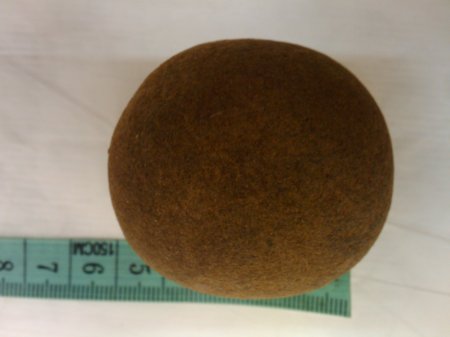Since there have been calls for some variety (skulls not good enough for you eh?) and there have even been accusations of the FMO being “too easy” I have decided to unleash a tricky one for you this week.

Scale in cm
Simple questions, what is it and what’s it made of?
No poll this week, just leave your thoughts in the comments section below. I will give you a clue however – it’s supposed to be magical (even Harry Potter’s used one).
More clues to follow if they’re needed!

Bezoar? And it looks like a hairy one.
Some sort of seed? Some sort of pathological stone (kidney stone, gall stone)?
Is it a hairball?
Dinosaur egg.
Is it a foetal furby/gremlin?
It is clearly a spherical ddklfjronbansk from the world of askdf asgkn nllllllll. It has not been polished and it has no magical powers at all.
Uh-oh, me thinks we pushed Paolo too far, he’s gone all Dr Evil on us! I can imagine his evil cackle as he selected the most morphologically indistinct object from his collection.
I too think it sounds, from the clue, like a bezoar, but that being the case it could be made from anything. It could be chitinous, keratinous or cellulose. Some bezoars contain a mineral called brushite (calcium hydrogen phosphate).
Final answer: bezoar made from mineralised keratin.
Past ones easy?! Paolo, if I had a pass rate of 36% I would have to conduct an investigation and explain myself to the examination board!!
Your father thinks it might be a ball-joint seen head on, i.e. hip or shoulder, possibly from a pine marten.
Is it that molecule that has so many different atoms its name is the longest in the English language by orders of magnitude? 357,000 letters or so I think it is.
Sorry for any typos I’ve lost my glasses again.
Do you mean the 189,819 letter IUPAC name for titin (aka connectin)?
No, it’s not that.
@Jim
Is “Bezoar made from mineralised keratin” a clever way of saying “hairball”?
(I’ve just googled bezoar, and I happen to know from my bottle of Alberto Balsam strawberry shampoo that it contains keratin enriching minerals – when they start mass producing laminated Nabokov that I can read in the shower I will be a happy woman!)
@Carmen
If you mean ‘is it a more technically precise, and not in any way obfuscatory, way of describing a bezoar such that it disambiguates such a stone from a term that would otherwise convey an image of fluffy hairiness’, then yes, yes I am.
;-p
@Jim
Hairballs aren’t always fluffy – my dad’s wife’s 3 cats are testament to that.
So to put it in a less obfuscatory but simplified way that the ordinary layperson (who might not be a fan of Harry Potter) would know:
It’s a hardened hairball?
😀
Is it a member of the posidonia family? like these?
http://www.bioone.org/action/showFullPopup?doi=10.1639%2F0007-2745%282001%29104%5B0503%3ANMOBII%5D2.0.CO%3B2&id=i0007-2745-104-3-503-f02
oh forgot to say they are made of sea moss. I found my first in tunisa only they were more sausage shaped. Guess it depends on the currents.
Is it an earthstar?
she just glanced at that before deciding what it might be!
So clearly a bezoar that it is worthy of no further comment! Very round though isn’t it?
Would be interested to hear what the professional procedure is for identifying an unidentified museum artefact. Is there a standard list of tests? Or a set of lists for different types of objects? Or is full rein given to your creativity? (e.g. ask your friends via a web poll) – not that I don’t have confidence in your ability to out-object-identify me 99 times out of 100 (or more).
Andy (drunk – so that’s alright then!)
The professional procedure for identifying an unidentified museum object varies. There is no standard list and there are a variety of different methods used.
In natural history we tend to rely on keys, detailed descriptions provided in authoritative books, well identified comparative material and our own knowledge.
With things like bezoars it becomes considerably more difficult to make identifications because they are so variable in their composition (not that I’m admitting it’s a bezoar – I’m not saying what it is until Monday!).
AndyC asked a good question, despite drunk.
Can you get DNA tests, and are they expensive?
Keys? Are they like voucher specimens?